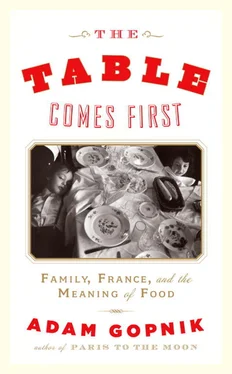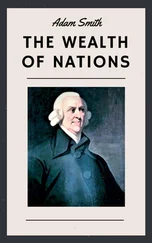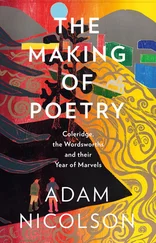Reading the primatologists and the anthropologists, I got the sense that the double life of sweets ever since the sugar revolution—as a thing we universally crave, and as a highly specific, French-derived cooking culture—has led to a strange fight between disciplines. The primatologists insist that we eat sugar because our genes scream for it, while their humanist colleagues insist that sugar is above all a cultural symbol—we eat as many sweets as we can in order to emulate the rich, who usually get to eat more. This is, of course, a little like the argument that the average man wants to make love to supermodels in order to be like rock stars and quarterbacks. (We do want to be like rock stars and quarterbacks, but this is because we envy them their girlfriends.) A power relationship and a primate past are both alive in us at once; the symbolic power relationships are an intrinsic part of the primate past. (Something can express a biological imperative and still be a symbolic ornament; the ruffle that your aunt puts on the toilet base is there to decorate, not disable, the toilet.)
Once again, an artifact and an appetite are not opposites to be reconciled but the same drive seen at different moments in its history. The lesser mouse lemur would doubtless devour a crème caramel and a butterscotch pudding indifferently; it takes a pastry chef trained in France to state the difference. The artifact gives the appetite shape; the appetite makes the artifact shine.
The next morning, I met Albert Adrià at the workshop that the Adrià brothers keep in the old quarter of Barcelona. In jeans and a work shirt, Albert had the stocky, proletarian look of a young Braque or Léger. He is a classic younger brother—earnest, hardworking, self-critical—and he explained the rise of the Barcelona dessert as a series of accidents disciplined by labor.
“Postres?” he asked. “Why me for postres ? First, because the pastry chef left. I had just finished moving through all the other stations, and I was due to be at the dessert. And I also have a severe allergy to shellfish, which limits my movement. But the real reason was that pastry seemed much more interesting—a world without limits. Meat cook? Fish cook? What are you going to do with it? And also there was a lot more to learn in pastry—just the techniques! My question was, Why can’t you serve main dishes that are sweet, and why can’t you have savory tastes during the dessert time period?”
I asked when the new style had first appeared. He furrowed his brow, trying to recollect something that had clearly not been the result of a deliberate plan. “It was an accident of the kitchen, really. I suppose we first made an ice cream with saffron in 1985. My first step is, I have to draw it. I have to sketch it, get it down on paper, and then do the explanatory texts.” He began to draw on paper. “This one I wanted to take up, this dirt—one of my most famous desserts involved dirt. A sweetened illusion. The idea came when it was winter at elBulli and I was going up the hill to get my car, and stuff was falling down, and I thought, Shit, that’s good! I can use that! It’s a dirt road, and, in the course of the fall, I noticed not only how the leaves changed color but also how they changed the color of the ground.” The dessert, as it was eventually plated, included cherry sorbet, salted honey yogurt, frozen chocolate powder, and spice bread, all evoking one fall moment: a dessert of frozen time.
Struggling to find words for his inventions, he began to speak about his most recent work: two desserts for the 2010 Cook It Raw conference, in Lapland, which would emphasize low-energy techniques, uncooked food. “Elemental, elemental,” he said. “That’s what I want. The really new idea I have for Lapland is—you see, I was thinking, if you were thirsty there you would eat the snow or the ice, and if you’re hungry you’re going to kill the reindeer. So: blood! The most basic thing is to drink the reindeer’s blood and eat the snow. So we made sweet snow and sweet blood. The key for the blood is your belief that it is. It looks like real blood only at a temperature of forty degrees—it’s a beet-and-orange reduction, and the texture, I promise, is exactly the same as blood. So we’re not telling people that it’s not real blood. It’s meant to be provocative. But it’s very delicious.”
“Is there anything that didn’t work out?” I asked. “Something that you tried and failed at?”
“A lot,” he said. “One of the first things that Ferran asked me to do was create hot ice cream.”
Hot ice cream! He nodded gloomily. “You would look at it—ice cream—and then you would taste it, and it would be hot. Every year I thought I had it! But I never had it. What we discovered was to use an ice-cream machine but invert it, so that it was pumping in hot air, and to use gelatin to get the form. That was as close as we could get. It’s still this idea that we have.” He shook his head. “A sort of dream. I have a lot of them.”
By now, the story of elBulli has become part of modern cooking lore: how the combination of science and culinary curiosity created a real revolution in cooking, with high-tech equipment borrowed from the mass-produced-food industry for the purpose of wild, semisurrealist picture-making. And how, at the height of this fame, Ferran announced that he would close the restaurant in 2012 and devote himself to “a foundation for pure research in cooking.” (What admirers of elBulli often forget to tell you is that it is a very hard place to get to. You weave your way there on narrow, winding cliff roads along the Spanish coast. The terror of the ascent surely adds to the delight of the arrival.)
If Albert is a Braque—a stolid man with a poetic imagination—Ferran is very much a Picasso, a grand maître who knows it. Like every first-rate artist, he has the kind of immense egomania that is oddly impersonal: his greatness is so uncontroversial to him that it is an act of generosity to try to limit it in words and dates. There is a certain kind of artistic egotism that is enveloping rather than narrowing: less “All I care about is my work” than “If you only cared about my work as much as I do, you would be as routinely elated as I am.”
I asked dutiful questions about the history, and the future, of desserts, and Ferran responded instantly, in Spanish, not with the guarded caution of his younger brother or the academic certainty of Jordi Butrón but with eager, nodding, flowing eloquence. His guttural, consonant-driven Catalan accent made everything he said sound as though he were murmuring a list of Jewish holidays. “Let us go all the way back to Carême and then come forward to us! Hmm. The problem! The problem! The phrase ‘molecular gastronomy’ I don’t like. ‘Techno-emotional’? I’m not crazy about it, but let’s use it. Now let’s look at the history of desserts.”
He called for paper and pen from one of his countless earnest, eager apprentices, and began to draw floridly and actively, making swooping charts of the history of cuisine, filled with Venn-diagram-like circles enclosing famous names and long arcs and arrows connecting one significant moment with the next. He drew as he talked—I realized that he was the inventor of the Barcelona diagram—and soon turned to sketching boxes and vectors on a large sheet of white paper.
“Carême, you see, was a pastry chef,” he said. “Everybody thinks of him as a cook, but he was actually a pastry chef. Sugar?” He took two for his coffee. “He was the best pastry chef in France. Now, come to our own time, who’s the great innovator?” Dramatic pause. “Michel Guérard!” He trumped with the name of the chef best known as a father of nouvelle cuisine, in the 1970s. “And he was a pastry chef, too. Very interesting that two revolutionaries have been pastry chefs. Whatever they’ve tried to do, they’ve tried this symbiosis of the savory world and the sweet. Escoffier, more than being a cook, was a codifier. I don’t know why it played out this way, but it did. Since then, Gaston Lenôtre and Pierre Hermé. And, after that, nothing, really. It’s been consolidated, but nothing very new came out of it in France. Why did Michel Guérard begin this revolution? Because he was a pastry chef, and the pastry chef was the second-class citizen of the kitchen. He did it to show ‘I am a cook.’ It’s the thinking of a pastry chef that initiated the revolution of nouvelle cuisine!” He looked at me keenly, to see if I was following.
Читать дальше












